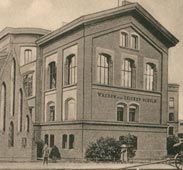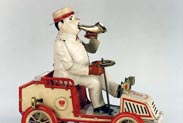Arts, toys and steel -
all made in Brandenburg
August Julius Wredow, who was born in Brandenburg an der Havel in 1804, enjoyed a very successful career on the Berlin art scene of the 19th century. He bequeathed a school of art and an art collection to the city of Brandenburg in 1872. The school still provides art education for children, adolescents and craft workers in accordance with his wishes. The school Stiftung Wredow’sche Zeichenschule is one of Germany’s oldest art foundations. One of Wredow’s most important works, the goddess of victory, can be seen on the Schlossbrücke bridge in Berlin. In Brandenburg, his sculpture of Paris can be admired at the foot of Marienberg (10) .
“Berlin was built out of a boat” was the title of special exhibition once staged at the Brandenburg Stadtmuseum. What is meant by this is that Berlin was not only built of sand and bricks from Brandenburg, the materials were also transported to Berlin in Brandenburg boats. The shipyard (6) founded by the Wiemann brothers in 1877 is located right in the middle of the Havel city at the Jahrtausendbrücke bridge. Many of the old ships, including the 100-year-old steamer “Nordstern”, are still in use. The Historischer Hafen association organizes regular round trips and takes part in the annual Harbour Festival in August.
When 25-year-old book-keeper and inventor Ernst Paul Lehmann from Berlin-Charlottenburg and his associate Jean Eichner founded a metal toy manufactory in Brandenburg in 1881, nobody would ever have guessed that these mobile toys would continue to find a market for over a century. The art nouveau Lehmann villa (7) and the big factory building (8) behind it in the old city still bear witness to this success story. The Museum im Frey-Haus, which is housed in a building donated by Lehmann to the city, has an exhibition about the history and the products of this and other Brandenburg toy manufacturers.
Brandenburg is not just famous for its toys, it is also renowned for steel production. Steel has been smelted in Brandenburg for over one hundred years – right up to the present day. Its history and that of the last preserved Siemens-Martin furnace in western Europe is presented over a 3,400 m² exhibition area in the Industriemuseum.

